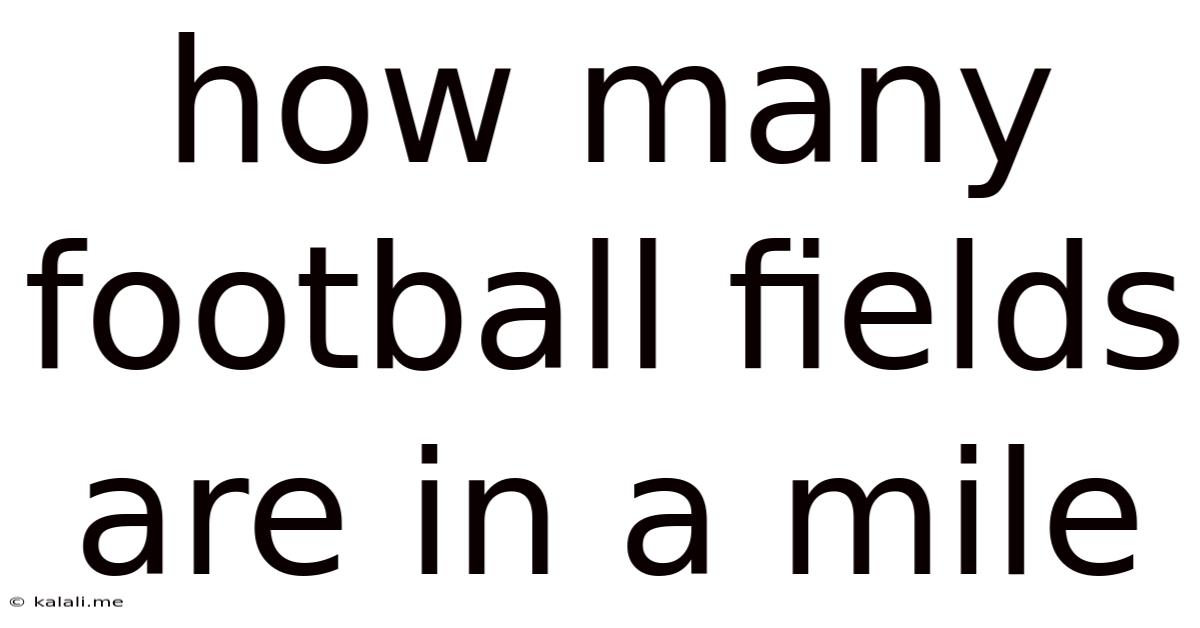How Many Football Fields Are In A Mile
Kalali
Jul 04, 2025 · 4 min read

Table of Contents
How Many Football Fields Are in a Mile? A Comprehensive Look at Field Dimensions and Conversions
Ever wondered how many football fields would stretch across a mile? It's a question that sparks curiosity, prompting us to consider the relative sizes of familiar units of measurement. This seemingly simple question delves into the specifics of football field dimensions, conversion calculations, and even the subtle variations between different football codes. This article will provide a comprehensive answer, exploring the intricacies of the calculation and addressing potential misconceptions.
Understanding the Basics: Football Field Dimensions and the Mile
Before diving into the calculation, let's establish the foundation. The standard American football field, excluding end zones, measures 100 yards in length. Adding the two end zones, each 10 yards deep, brings the total length to 120 yards. A yard contains 3 feet, meaning the total length of a football field including end zones is 360 feet (120 yards * 3 feet/yard).
A mile, on the other hand, is a significantly larger unit of measurement, equaling 5280 feet. This fundamental difference in scale immediately sets the stage for our conversion.
The Calculation: Determining the Number of Football Fields in a Mile
To determine how many football fields fit into a mile, we perform a simple division:
5280 feet (one mile) / 360 feet (one football field) = 14.67 football fields
Therefore, approximately 14.67 football fields would stretch across one mile. This means that slightly less than 15 football fields would be required to cover the distance of a mile.
Variations in Football Field Dimensions: Considering Other Codes
While the above calculation uses the standard dimensions of an American football field, it's crucial to acknowledge that other football codes (like Canadian football, Gaelic football, Australian rules football, and rugby) have different field dimensions. These variations will naturally affect the final calculation.
For example, a Canadian football field is longer than its American counterpart. Therefore, fewer Canadian football fields would fit within a mile. Similarly, fields used in other football codes, often rectangular rather than simply longer, introduce additional complexities. A precise calculation would require specifying the exact dimensions of the football field in question.
Beyond the Simple Calculation: Practical Applications and Considerations
The seemingly straightforward calculation of 14.67 football fields per mile offers a practical, intuitive understanding of scale. This can be useful in several contexts:
- Estimating distances: Imagine you are planning a long-distance run or bike ride. Visualizing the distance in terms of the familiar length of a football field can make the task seem less daunting and help with pacing.
- Spatial reasoning: Understanding the relationship between football fields and miles enhances spatial reasoning skills, helping individuals better visualize distances and areas.
- Real-world applications: Architects, urban planners, and other professionals often use familiar units like football fields to communicate and visualize large-scale projects.
Addressing Potential Misconceptions and Nuances
It's important to address potential misunderstandings that could arise from this calculation:
- End zones are included: The calculation includes the end zones in the total length of the football field. If end zones were excluded, the number of fields per mile would increase slightly.
- Precision vs. approximation: The result of 14.67 is an approximation. In reality, you cannot fit a fraction of a football field.
- Field markings and surrounding areas: The calculation focuses solely on the playing field's dimensions. It doesn't account for the width of the field or surrounding areas like sidelines, which would increase the total area required.
Expanding the Scope: Exploring Related Calculations and Conversions
The calculation of football fields per mile opens the door to related conversions and calculations:
- Football fields to kilometers: Converting the length of a football field into kilometers provides a metric equivalent.
- Acres to football fields: Determining how many football fields fit within an acre helps visualize land area.
- Comparing field sizes across different sports: Comparing the size of a football field to other sports fields, like baseball diamonds or soccer pitches, provides a relative understanding of playing area.
Conclusion: More Than Just a Calculation
While the answer to "How many football fields are in a mile?" is approximately 14.67, the process of arriving at this answer offers a valuable opportunity to explore concepts of measurement, conversion, and spatial reasoning. The question's simplicity belies the nuances and applications involved, extending beyond a simple mathematical exercise. By understanding the calculation and its implications, we gain a deeper appreciation for the relative sizes of familiar units of measurement and their practical applications in various contexts. From estimating distances to visualizing large-scale projects, this seemingly simple calculation holds a surprising amount of significance. Moreover, the consideration of different football codes highlights the importance of clarifying specifics and acknowledging variations in order to achieve accurate results. The exploration further extends to related conversions and calculations, enriching our understanding of spatial relationships and measurement in general.
Latest Posts
Latest Posts
-
I Was Born In 1971 How Old Am I
Jul 31, 2025
-
Which Statement Best Illustrates An Example Of Economic Specialization
Jul 31, 2025
-
Is 6 Inches Of Rain A Lot
Jul 31, 2025
-
What Grade Is 20 Out Of 30
Jul 31, 2025
-
How Many Legs Does A Cat Have
Jul 31, 2025
Related Post
Thank you for visiting our website which covers about How Many Football Fields Are In A Mile . We hope the information provided has been useful to you. Feel free to contact us if you have any questions or need further assistance. See you next time and don't miss to bookmark.